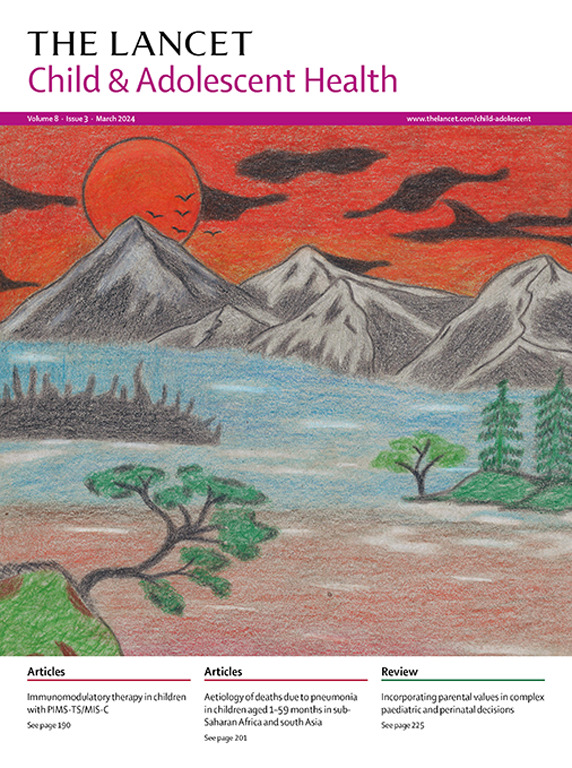Late effects after high-risk neuroblastoma (LEAHRN): a multicentre, cross-sectional cohort study from the Children's Oncology Group
IF 15.5
1区 医学
Q1 PEDIATRICS
引用次数: 0
Abstract
Background
New treatment regimens have resulted in increasing numbers of children who survive high-risk neuroblastoma, but late effects of cancer therapy are not well studied. We aimed to explore treatment-related risk factors associated with late effects of modern therapies for high-risk neuroblastoma.
Methods
This multicentre, cross-sectional cohort study of survivors of high-risk neuroblastoma was done at 88 hospitals participating in the Children's Oncology Group (COG) in North America, Australia, and New Zealand. Eligible participants were aged 5–50 years at enrolment, were enrolled on ANBL00B1, were diagnosed with high-risk neuroblastoma on or after Jan 1, 2000, were alive at least 5 years after diagnosis, and had language skills in English, French, or Spanish. Individuals with active neuroblastoma relapse (cytotoxic chemotherapy in the previous 2 years) were ineligible. Participant evaluations included an audiogram, pulmonary function test, echocardiogram, and laboratory studies. Exposures were abstracted via chart review. Prevalence of a specific late effect was calculated as the number of participants with the late effect divided by the sample size with known data for that late effect. Multivariable logistic regression models examined associations between treatment-related risk factors versus hearing loss, growth failure, underweight, and restrictive lung disease.
Findings
Between June 5, 2017 and Sept 17, 2021, 375 eligible participants were enrolled from 890 potentially eligible individuals. Median age at high-risk neuroblastoma diagnosis was 2·5 years (range 0·2–15·8), median age at enrolment was 12·0 years (5·0–24·0), and median time from diagnosis to enrolment was 9·0 years (5·1–18·2). All participants received chemotherapy, 363 (97%) of 375 received at least one stem cell transplant and 231 (64%) of 363 patients with known data received anti-GD2 therapy. Moderate-to-severe hearing loss was identified in 236 (72%) of 327 participants. Growth failure was identified in 87 (24%) of 360 and underweight in 190 (51%) of 373. Pulmonary function tests revealed moderate-to-severe restrictive lung disease in 17 (8%) of 207 participants. Longer follow-up was associated with a higher prevalence of late effects. Compared with single stem-cell transplant, exposure to tandem stem-cell transplant was associated with increased risk of growth failure (odds ratio [OR] 3·4 [95% CI 1·6–7·2], p=0·0016] and moderate-to-severe restrictive lung disease (OR 4·5 [1·1–18·3]; p=0·033). Neither conditioning regimen exposure (carboplatin–etoposide–melphalan vs busulfan–melphalan) nor anti-GD2 therapy was associated with increased risk of hearing loss, underweight, growth failure, or restrictive lung disease.
Interpretation
Survivors of high-risk neuroblastoma treated with modern therapies demonstrated a substantial burden of late effects, providing crucial information for future care and clinical trial design.
Funding
The Children's Oncology Group National Clinical Trials Network (NCTN) Statistics and Data Center, NCTN Operations Center, St Baldrick's Foundation Consortium, National Cancer Institute Community Oncology Research Programme, and Dana-Farber Cancer Institute Neuroblastoma Research Fund.
高风险神经母细胞瘤(LEAHRN)后的晚期效应:一项来自儿童肿瘤组的多中心横断面队列研究。
新的治疗方案导致越来越多的高危神经母细胞瘤儿童存活,但癌症治疗的后期效应尚未得到很好的研究。我们的目的是探索与高风险神经母细胞瘤现代治疗晚期效应相关的治疗相关危险因素。方法这项多中心、横断面队列研究在北美、澳大利亚和新西兰儿童肿瘤组(COG)的88家医院进行,研究对象为高危神经母细胞瘤幸存者。符合条件的受试者入组时年龄为5-50岁,使用ANBL00B1,在2000年1月1日或之后被诊断为高危神经母细胞瘤,在诊断后存活至少5年,具有英语、法语或西班牙语语言能力。活跃的神经母细胞瘤复发(前2年有细胞毒性化疗)的个体不适合。参与者的评估包括听力图、肺功能检查、超声心动图和实验室检查。通过图表回顾提取暴露信息。特定延迟效应的流行率计算为具有延迟效应的参与者人数除以具有该延迟效应已知数据的样本量。多变量logistic回归模型检验了治疗相关危险因素与听力损失、生长衰竭、体重不足和限制性肺部疾病之间的关系。在2017年6月5日至2021年9月17日期间,从890名潜在符合条件的个体中招募了375名符合条件的参与者。高危神经母细胞瘤诊断时的中位年龄为2.5岁(范围0.2 - 15.8),入组时的中位年龄为12.0岁(范围5.0 - 24.0),从诊断到入组的中位时间为9.0岁(范围5.1 - 18.2)。所有参与者都接受了化疗,375名患者中有363名(97%)接受了至少一次干细胞移植,363名已知数据患者中有231名(64%)接受了抗gd2治疗。327名参与者中有236人(72%)出现中度至重度听力损失。360人中有87人(24%)生长失败,373人中有190人(51%)体重不足。肺功能测试显示,207名参与者中有17人(8%)患有中度至重度限制性肺部疾病。随访时间越长,晚期效应的发生率越高。与单一干细胞移植相比,接受串联干细胞移植与生长衰竭的风险增加相关(比值比[OR] 3.4 [95% CI 1.6 - 7.2], p= 0.0016]和中至重度限制性肺部疾病的风险增加相关(比值比[OR] 4.5 [1.1 - 18.3], p= 0.033)。调节方案暴露(卡铂-依泊泊苷-美法兰vs布苏芬-美法兰)和抗gd2治疗均与听力损失、体重不足、生长衰竭或限制性肺部疾病的风险增加无关。解释:接受现代疗法治疗的高危神经母细胞瘤幸存者表现出了巨大的晚期效应负担,这为未来的护理和临床试验设计提供了重要信息。资助:儿童肿瘤组织国家临床试验网络(NCTN)统计和数据中心、NCTN运营中心、St Baldrick基金会联盟、国家癌症研究所社区肿瘤研究计划和Dana-Farber癌症研究所神经母细胞瘤研究基金。
本文章由计算机程序翻译,如有差异,请以英文原文为准。
求助全文
约1分钟内获得全文
求助全文
来源期刊

Lancet Child & Adolescent Health
Psychology-Developmental and Educational Psychology
CiteScore
40.90
自引率
0.80%
发文量
381
期刊介绍:
The Lancet Child & Adolescent Health, an independent journal with a global perspective and strong clinical focus, presents influential original research, authoritative reviews, and insightful opinion pieces to promote the health of children from fetal development through young adulthood.
This journal invite submissions that will directly impact clinical practice or child health across the disciplines of general paediatrics, adolescent medicine, or child development, and across all paediatric subspecialties including (but not limited to) allergy and immunology, cardiology, critical care, endocrinology, fetal and neonatal medicine, gastroenterology, haematology, hepatology and nutrition, infectious diseases, neurology, oncology, psychiatry, respiratory medicine, and surgery.
Content includes articles, reviews, viewpoints, clinical pictures, comments, and correspondence, along with series and commissions aimed at driving positive change in clinical practice and health policy in child and adolescent health.
 求助内容:
求助内容: 应助结果提醒方式:
应助结果提醒方式:


